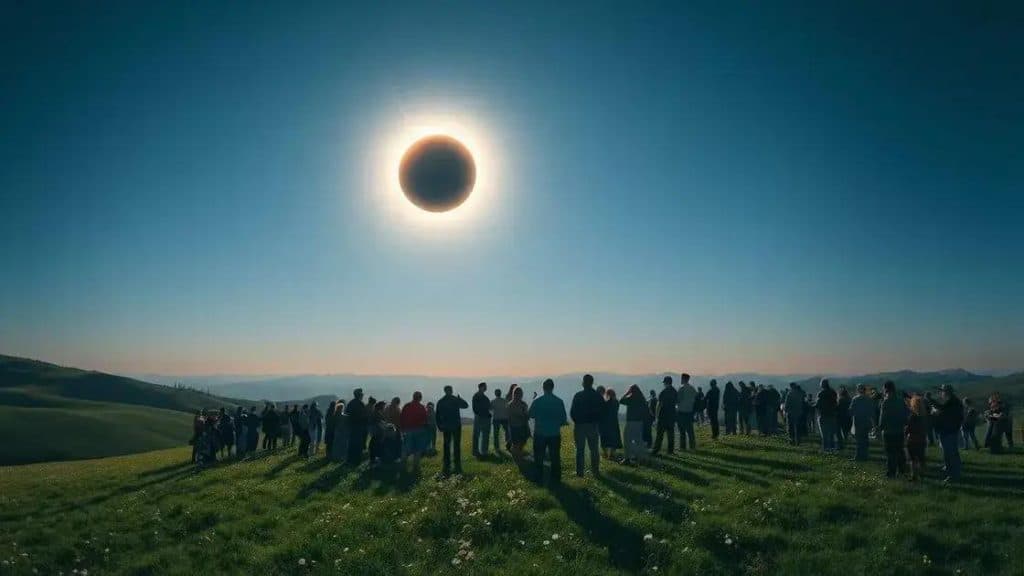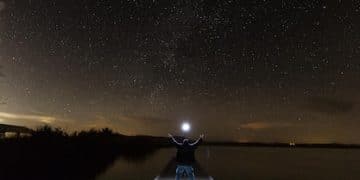Upcoming solar eclipses and viewing tips you can’t miss

Upcoming solar eclipses present a unique opportunity to witness magnificent celestial events, where the Moon obscures the Sun, creating enchanting sights and altering environmental conditions, all while requiring proper eye protection for safe viewing.
Upcoming solar eclipses and viewing tips might just transform your weekend into an unforgettable experience. Have you ever wondered how to catch these magnificent events? Let’s dive into some exciting details!
What exactly is a solar eclipse?
A solar eclipse occurs when the Moon passes between the Earth and the Sun, blocking the sunlight either partially or completely. These events are rare but captivating, sparking excitement among skywatchers.
Understanding the different types of solar eclipses can enhance your viewing experience. There are three main types:
Total solar eclipse
In a total solar eclipse, the Moon completely covers the Sun. This phenomena allows observers in the path of totality to see a stunning corona of the Sun’s atmosphere.
Partial solar eclipse
During a partial solar eclipse, only a part of the Sun is obscured by the Moon. This means you can still see some sunlight in various areas.
Annular solar eclipse
An annular solar eclipse happens when the Moon is too far away from Earth to completely cover the Sun, resulting in a ring-like appearance. This “ring of fire” is a spectacular sight for viewers.
Experiencing a solar eclipse is thrilling. As the Moon moves across the Sun, daylight dims, birds may quiet down, and a drop in temperature occurs. Observers often describe feeling a sense of awe and excitement as the sky changes.
Unlike lunar eclipses, which can be seen from anywhere on the night side of Earth, solar eclipses can only be seen from specific areas. Thus, planning your viewing location is essential.
Best locations for viewing upcoming solar eclipses

Finding the best locations for viewing upcoming solar eclipses is key to experiencing this phenomenal event. Some spots offer optimal visibility and stunning landscapes, enhancing the overall experience.
National Parks
Many national parks are ideal for eclipse viewing due to their open skies and spectacular natural settings. Parks often host special events to celebrate the occasion.
- Yellowstone National Park
- Grand Canyon National Park
- Yosemite National Park
Large Cities
Cities provide a unique backdrop for solar eclipses. Viewing from urban areas allows for a vibrant atmosphere and the chance to share the experience with others.
- Indianapolis, Indiana
- Kansas City, Missouri
- Nashville, Tennessee
When searching for the perfect spot, consider places known for clear skies during the eclipse season. Ideal weather conditions can greatly enhance your viewing experience. Some regions may have clouds, while others remain clear.
It’s also essential to check the path of totality, which is where viewers will experience the full effects of the eclipse. Planning ahead will ensure you are in the right place at the right time.
Essential tips for watching solar eclipses safely
Watching a solar eclipse can be a thrilling experience, but safety must always come first. There are specific essential tips for watching solar eclipses safely that every observer should know.
Use Proper Eye Protection
First and foremost, you must protect your eyes. Looking directly at the Sun can cause serious eye damage. Always use certified eclipse glasses or solar viewers that meet the ISO 12312-2 international safety standard.
Don’t Use Regular Sunglasses
Regular sunglasses, no matter how dark they are, do not provide adequate protection during a solar eclipse. Ensure you have proper glasses specifically made for eclipse viewing.
- Certified eclipse glasses are necessary.
- Check for any damage before use.
- Use solar filters on telescopes or binoculars.
For those using telescopes or cameras, it’s vital to use solar filters. Regular cameras or telescopes can damage your eyesight if pointed directly at the Sun without the proper equipment.
Plan Your Viewing Location
Finding the best spot with a clear view of the sky is essential. Check the weather forecast ahead of time. Locations with fewer obstructions, such as tall buildings or trees, are preferable.
Arriving early can help you find the best spot and avoid crowds. Remember, an eclipse can attract large groups of people, so it’s wise to plan ahead for a hassle-free experience.
What to expect during the solar eclipse event

During a solar eclipse, there are many fascinating things to expect. As the Moon moves in front of the Sun, a series of changes occur in the sky and environment around you. It’s more than just a visual spectacle; it’s a unique experience.
Changes in Light and Temperature
As the eclipse progresses, you’ll notice the lighting changing dramatically. The sky will gradually darken, and shadows will appear sharper. You might even feel a drop in temperature as the Sun’s light gets partially or completely blocked.
- Bright daylight will turn to twilight.
- The temperature may decrease slightly.
- Nearby animals often react to these changes.
Wildlife Reactions
During a solar eclipse, many animals become confused. Birds may stop singing, and some animals prepare for nighttime. You might witness unusual behaviors from wildlife, which adds to the overall experience.
Expect to hear gasps and cheers from the crowd as the event unfolds. Sharing this moment with others can heighten the excitement. People from all walks of life gather to witness this celestial phenomenon.
The Appearance of the Solar Corona
If you are in the path of totality during a total solar eclipse, you will see the solar corona. This is the outer atmosphere of the Sun, which becomes visible as a beautiful halo. It’s a stunning sight that highlights the eclipse and creates a magical atmosphere.
As the moments of totality approach, prepare for a wave of excitement. Be ready to capture this incredible event, but remember to protect your eyes if you’re watching the partial phases again once totality ends.
In conclusion, witnessing a solar eclipse is a breathtaking experience that combines science and wonder. By knowing what to expect, such as changes in light and wildlife behavior, you can fully enjoy the moment. Remember to prioritize safety by using proper eye protection and finding a great viewing location. With the right preparation, you will create unforgettable memories as you observe this celestial event.
FAQ – Questions about Solar Eclipses and Viewing
What is a solar eclipse?
A solar eclipse occurs when the Moon passes between the Earth and the Sun, blocking the Sun’s light.
How can I safely watch a solar eclipse?
Always use certified eclipse glasses or solar viewers to protect your eyes; regular sunglasses are not sufficient.
What changes can I expect during an eclipse?
You will notice changes in light, temperature, and even wildlife behavior as the eclipse occurs.
Where is the best place to view a solar eclipse?
The best places include open areas such as national parks or cities that fall within the path of totality.





